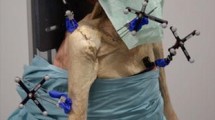Abstract
In ten human cadaveric shoulder specimens four different parameters were documented prior to, and after, dissecting all passive stabilizers. These included the vertical, horizontal and mediolateral acromioclavicular distance, as well as the clavicular rotation. In addition, the same parameters were documented after acromioclavicular (AC) reconstruction using eight different techniques. The results showed a good reconstruction of the vertical ac-distance. Most of the techniques, especially the coracoid-sling procedure, led to a significant anterior displacement of the clavicle in relation to the scapula. To a lesser degree, most of the conventional procedures also resulted in a lateralization of the acromion and/or clavicular rotation. A bone anchor system for distal fixation in the base of the coracoid process and a medialized hole in the clavicle restored anatomy best. This new technique therefore is recommended for anatomical AC-reconstruction.
Similar content being viewed by others
Author information
Authors and Affiliations
Additional information
Received: 13 November 1998 Accepted: 20 April 1999
Rights and permissions
About this article
Cite this article
Jerosch, J., Filler, T., Peuker, E. et al. Which stabilization technique corrects anatomy best in patients with AC-separation? An experimental study. Knee Surgery 7, 365–372 (1999). https://doi.org/10.1007/s001670050182
Issue Date:
DOI: https://doi.org/10.1007/s001670050182




